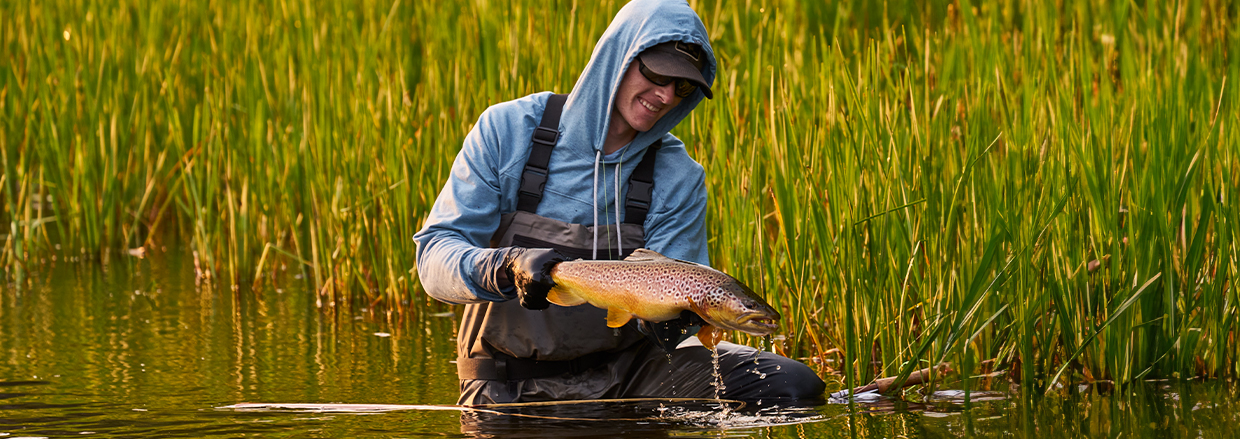Fly-Fishing Clothing

What to Wear for Fly-Fishing
Fly-fishing calls for a lot of patience as you spend hours standing in water. That means, you will require comfortable and durable clothing to work through splashing waves, fighting fish and sometimes the rain.
Here are our top recommendations to help you prepare for a successful and enjoyable day in water.
Gear for Fishing in the Water
Stockingfoot Waders
If you hike a fair distance to get to your favourite spot, then stockingfoot waders are the ideal choice. Stockingfoot waders provides you with a chance to buy separate wading boots that fit with more precision.
Bootfoot Waders
Bootfoot waders are warmer when compared with stockingfoot waders. These waders keep your feet warm for long periods of time, making them a great choice for early or late season fishing when the water is very cold.
Wading Boots
There are different types of wading boots which can be differentiated based on the material of their soles.
- Felt soles are preferred by traditional fly-fishermen (check for local restrictions).
- Rubber soles provide flexibility, grip, durability and they are easy to maintain.
- Vibram soles offer grip even in slippery conditions with extra durability.
How to Choose the right Wading Boots

The right wading boots can turn your fishing adventure into success. Here are a few things to consider before choosing your wading boots:
Traction and Ankle Support
- As many river bottoms can be rocky, unstable and dangerous, it is vital to consider good ankle support when choosing your wading boots.
- Traction is a nonnegotiable feature to have in wading boots. While navigating stream reaches which are usually covered in loose gravel, steep hills and slippery surfaces, wading boots with good grip and traction will help you navigate safely.
Deciding the Size:
As a rule of thumb, pick one size up from your regular hiking shoes. This extra space will help the wading socks to fit in perfectly. During the early season, the extra half-size should account for wool or thermal socks to keep your feet warm in cold water.
Soles: Rubber and felt are the two most common soles in wading boots.
- Rubber soles offer excellent traction and sturdiness, making them a great option for anglers who take long treks through the woods.
- Felt soles (check for local restrictions) have an inch-thick layer of felt attached to the soles for grip on wet and slippery rocks. The felt layer provides traction by compressing and molding in shapes of stone/gravel, even when wet. Although these tend to wear down over time, they are easily replaceable.
- Studded or cleated soles have several small metal built-in spikes into toe and heel sections to give you serious traction even in the most slippery conditions.
- Vibram soles are a blend of foam and rubber. They make a good option for walking on muddy and snowy trails. These soles are known for their durability, grip, comfort, and traction.

Styles: From heavy-duty hiking boot models to lightweight sneaker styles, choose the type based on your needs.
- Sturdy hiking boot models: Durable, ideal to walk long distances, and traverse around obstacles.
- Lightweight models: Boots with felt soles are great for all streams.
- Sneaker models: Ideal for low-water streams or coastal areas.
Quality:
Good quality wading boots and laces (nylon or polypropylene to sustain constant pressure) have water-repellent synthetic materials or full-grain Nubuck leather for durability.
Tip:
Check how the boot’s tongue is attached to the footwear. It’s ideal to have the tongue sewn straight up the side of the boot to avoid any free space or debris to get into.
Fly-Fishing Vests
Nowadays, there are myriad choices for fly-fishing vests. Whatever interests you, ensure you have the following features to support your adventures.
A good vest should always have ample storage to carry your gear, be temperature-resistant to protect you against elements and be lightweight that it won’t weigh you down.
- Insulation: Opt for a vest with thermal insulation for colder weather. Invest in a vest with ventilation to stay cool in warmer and hot weather. Simms vests are lightweight and designed to keep you comfortable on warm days.
- Gear carrying capabilities: If you plan to carry a lot of gear, you will need a vest with plenty of storage space. A few vests have up to 18 pockets that can hold reels, fly boxes, and other gear.
- Comfort: Longer fly-fishing trips or a long day on the water often involve a lot of walking, so it’s essential to choose a vest that provides comfort. Based on your preference, choose vests either with more padding or less padding.
- Ventilation: A well-ventilated vest keeps you cool on a hot day on water. Vests with mesh panels or ventilation holes help air circulation to keep you comfortable.
- Durability: You’ll be wearing your vest in rugged conditions. Having a vest made from tough materials like polyester will withstand challenges. Look for strong zippers and seams in the vest.